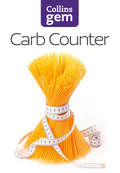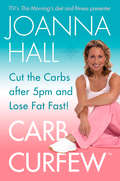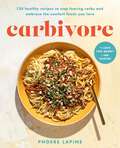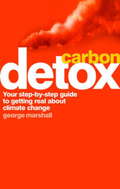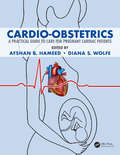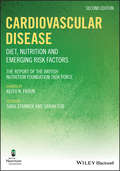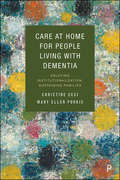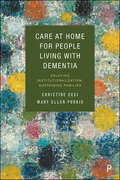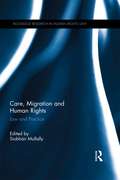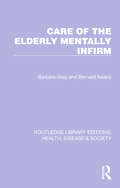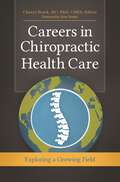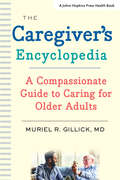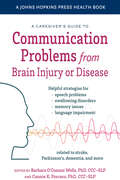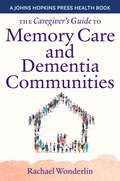- Table View
- List View
Carb Counter: A Clear Guide To Carbohydrates In Everyday Foods (Collins Gem)
by HarperCollinsThe ideal companion to the hugely successful Gem Calorie Counter, this is a handy portable guide to carbohydrates in everyday foods now improved and optimised for e-readers and tablet devices, with fully searchable text and tables. Perfect for those following the Fast Diet (5:2 Diet), Dukan Diet, Atkins Diet or other weight-loss diets.
Carb Curfew: Cut The Carbs After 5pm And Lose Fat Fast!
by Joanna HallJoanna Hall, the popular diet and fitness presenter for ITV’s This Morning show, reveals her simple 5 step fat loss plan. The golden rule is ‘no carbs after 5pm’ – and with Joanna Hall’s help the rest is easy!
Carbivore: 130 Healthy Recipes to Stop Fearing Carbs and Embrace the Comfort Foods You Love
by Phoebe LapinePut Carbs Back on the Table! Diet trends come and go, but over the last decade, no one food group has been vilified and misunderstood as much as carbs. A hundred years ago, our relatives got more than 50 percent of their nutrients from carbs, and yet the chronic conditions we grapple with today were rare. The good news is that carbs don&’t have to be the enemy of your blood sugar or hormone health, nor are they the secret agents of inflammation.Carbivore is a new way to reclaim your favorite comfort foods without the consequences. Whether you&’re suffering from keto-fatigue, have been told carbs are off the table because of health issues, or just want to embrace food freedom without fear, Phoebe Lapine offers a delicious solution with 130 completely fiber-forward (gluten-optional) recipes that are organized by your favorite type of carb—noodles, grains, loaves, spuds and more. As she did in her invaluable gut health guide, SIBO Made Simple, Phoebe will cure your carb confusion and show you how to &“have your cake and eat it too&” with strategies like her signature &“carb companions.&” This book is a mouth-watering culinary adventure that will allow you to balance your blood sugar, support hormone health, and limit autoimmune symptoms, all while embracing the foods you love.
Carbohydrate loading (Large Print)
by Rnib BookshareThis is an image of a tall and very thin man. There is a locator dot shown, which will be at the top left of the page when the image is the right way up. He has prominent cheeks, ribs and collar bones. He stands facing you with his head at the top centre of the page and feet at the bottom of the page. His arms are to the left and right of his body. The size and shape of his body can be clearly found as he is only wearing swimming trunks.
Carbohydrate loading (UEB Contracted)
by Rnib BookshareThis is a diagram showing four different diets and training plans in the week before performing in a competition, set out in a table of 8 columns and 5 rows. There is a locator dot shown, which will be at the top left of the page when the image is the right way up. The four different diet and training plans are shown in 4 rows across the page and are separated by thin solid horizontal lines. The columns are headed by the number of days before the competition starting with 7 at the left and 1 at the right. At the very right is a column showing the rise in muscle glycogen achieved as a result of the relevant training and diet regime.
Carbohydrate loading (UEB Uncontracted)
by Rnib BookshareThis is a diagram showing four different diets and training plans in the week before performing in a competition, set out in a table of 8 columns and 5 rows. There is a locator dot shown, which will be at the top left of the page when the image is the right way up. The four different diet and training plans are shown in 4 rows across the page and are separated by thin solid horizontal lines. The columns are headed by the number of days before the competition starting with 7 at the left and 1 at the right. At the very right is a column showing the rise in muscle glycogen achieved as a result of the relevant training and diet regime.
Carbon Detox: Your step-by-step guide to getting real about climate change
by George MarshallReduce your carbon footprint from day 1 - "Carbon Detox" explains the changes each of us can make at home, at work and in every aspect of our lives. From summer heat waves to rising sea levels, climate change affects us all. The main cause is carbon dioxide and our carbon emissions are growing year by year at a frightening rate. However, there is hope. The changes we make now can slow the effects of climate change and preserve the planet for future generations. George Marshall shows you how to carbon audit your life and start reducing your impact today. He also explains how to overcome psychological blocks such as scepticism, fear and feelings of insignificance. This book includes advice on low carbon transport options and holidays and how to create an energy-efficient home. With the help of "Carbon Detox" you will be able to make real differences from day 1.The author's charity will provide extensive cross-promotional support including talks and workshop events. This is the first book to show how the ordinary 'non-greenie' can make realistic and meaningful changes. It is written by an expert author who lives in a low carbon home. It features carbon calculators for the home, transport and food.
Cardio-Obstetrics: A Practical Guide to Care for Pregnant Cardiac Patients
by Afshan B. Hameed and Diana S. WolfeCardiac disease is one of the leading causes of maternal morbidity and mortality. Catastrophic outcomes typically encountered are due to gaps in knowledge and communication between health care providers. There is a great need for a standardized approach for care of this very high-risk group of pregnant women. The book encompasses detailed obstetrics and cardiology perspectives that are crucial in the management of the commonly encountered cardiac conditions in pregnancy. This text aims to provide guidance to the whole team caring for a pregnant cardiac patient consisting of obstetricians, maternal-fetal medicine, hospitalists, cardiologists, obstetric anaesthesiologists, emergency physicians, primary care providers and nurses. Features: Cardio-Obstetric team organization Preconception counselling and family planning considerations Cardiovascular disease screening and risk stratification of a pregnant cardiac patient Management of a wide spectrum of cardiovascular diagnoses through use of checklists and algorithms in a simple format Essential key points for each cardiac diagnosis
Cardio-Obstetrics: A Practical Guide to Care for Pregnant Cardiac Patients
by Afshan B. Hameed Diana S. WolfeCardiac disease is one of the leading causes of maternal morbidity and mortality. Catastrophic outcomes typically encountered are due to gaps in knowledge and communication between health care providers. There is a great need for a standardized approach for care of this very high-risk group of pregnant women. The book encompasses detailed obstetrics and cardiology perspectives that are crucial in the management of the commonly encountered cardiac conditions in pregnancy. This text aims to provide guidance to the whole team caring for a pregnant cardiac patient consisting of obstetricians, maternal-fetal medicine, hospitalists, cardiologists, obstetric anaesthesiologists, emergency physicians, primary care providers and nurses. Features: Cardio-Obstetric team organization Preconception counselling and family planning considerations Cardiovascular disease screening and risk stratification of a pregnant cardiac patient Management of a wide spectrum of cardiovascular diagnoses through use of checklists and algorithms in a simple format Essential key points for each cardiac diagnosis
Cardiovascular Disease: Diet, Nutrition and Emerging Risk Factors (British Nutrition Foundation #1)
by Keith N. FraynA comprehensive, accessible summary of the latest research in heart disease risk factors Cardiovascular Disease (CVD) is a major cause of early death and disability across the world. The major markers of risk—including high blood cholesterol, smoking, and obesity—are well known, but studies show that such markers do not account for all cardiovascular risk. Written by a team of renowned experts in the field, this comprehensive and accessible book examines the evidence for emerging and novel risk factors, and their relationship with diet and nutrition. Fully updated throughout, Cardiovascular Disease: Diet, Nutrition and Emerging Risk Factors, 2nd Edition covers everything from the epidemiology of cardiovascular disease, to genetic factors, to inflammation and much more – offering invaluable advice on reducing risk factors and preventing CVD. This new edition: Authoritatively reports on the link between emerging aspects of diet, lifestyle and cardiovascular disease risk Focuses on novel risk factors of CVD, including the human gut microbiome and fetal and childhood origins, and how it can be prevented Features recommendations for interventions and future research Includes references, commonly asked questions that summarise the take-home messages, and an online glossary Cardiovascular Disease: Diet, Nutrition and Emerging Risk Factors, 2nd Edition is an important book for researchers and postgraduate students in nutrition, dietetics, food science, and medicine, as well as for cardiologists and cardiovascular specialists.
Cardiovascular Disease: Diet, Nutrition and Emerging Risk Factors (British Nutrition Foundation)
by Keith N. FraynA comprehensive, accessible summary of the latest research in heart disease risk factors Cardiovascular Disease (CVD) is a major cause of early death and disability across the world. The major markers of risk—including high blood cholesterol, smoking, and obesity—are well known, but studies show that such markers do not account for all cardiovascular risk. Written by a team of renowned experts in the field, this comprehensive and accessible book examines the evidence for emerging and novel risk factors, and their relationship with diet and nutrition. Fully updated throughout, Cardiovascular Disease: Diet, Nutrition and Emerging Risk Factors, 2nd Edition covers everything from the epidemiology of cardiovascular disease, to genetic factors, to inflammation and much more – offering invaluable advice on reducing risk factors and preventing CVD. This new edition: Authoritatively reports on the link between emerging aspects of diet, lifestyle and cardiovascular disease risk Focuses on novel risk factors of CVD, including the human gut microbiome and fetal and childhood origins, and how it can be prevented Features recommendations for interventions and future research Includes references, commonly asked questions that summarise the take-home messages, and an online glossary Cardiovascular Disease: Diet, Nutrition and Emerging Risk Factors, 2nd Edition is an important book for researchers and postgraduate students in nutrition, dietetics, food science, and medicine, as well as for cardiologists and cardiovascular specialists.
Care at Home for People Living with Dementia: Delaying Institutionalization, Sustaining Families
by Christine Ceci Mary Ellen PurkisWhat ‘kind’ of community is demanded by a problem like dementia? As aspects of care continue to transition from institutional to community and home settings, this book considers the implications for people living with dementia and their carers. Drawing on extensive fieldwork and case studies from Canada, this book analyses the intersections of formal dementia strategies and the experiences of families and others on the frontlines of care. Considering the strains placed on care systems by the COVID-19 pandemic, this book looks afresh at what makes home-based care possible or impossible and how these considerations can help establish a deeper understanding necessary for good policy and practice.
Care at Home for People Living with Dementia: Delaying Institutionalization, Sustaining Families
by Christine Ceci Mary Ellen PurkisWhat ‘kind’ of community is demanded by a problem like dementia? As aspects of care continue to transition from institutional to community and home settings, this book considers the implications for people living with dementia and their carers. Drawing on extensive fieldwork and case studies from Canada, this book analyses the intersections of formal dementia strategies and the experiences of families and others on the frontlines of care. Considering the strains placed on care systems by the COVID-19 pandemic, this book looks afresh at what makes home-based care possible or impossible and how these considerations can help establish a deeper understanding necessary for good policy and practice.
Care at Home for People Living with Dementia: Delaying Institutionalization, Sustaining Families
by Christine Ceci Mary Ellen PurkisWhat ‘kind’ of community is demanded by a problem like dementia? As aspects of care continue to transition from institutional to community and home settings, this book considers the implications for people living with dementia and their carers. Drawing on extensive fieldwork and case studies from Canada, this book analyses the intersections of formal dementia strategies and the experiences of families and others on the frontlines of care. Considering the strains placed on care systems by the COVID-19 pandemic, this book looks afresh at what makes home-based care possible or impossible and how these considerations can help establish a deeper understanding necessary for good policy and practice.
Care, Migration and Human Rights: Law and Practice (Routledge Research in Human Rights Law)
by Siobhán MullallyThe continuum of exploitation that has historically defined the everyday of domestic work - exclusion from employment and social security standards and precarious migration status – has frequently been neglected. It is primarily the moments of crisis, incidents of human trafficking, slavery or forced labour, that have captured the attention of human rights law. Only recently has human rights law has begun to address the structured inequalities and exclusions that define the domain of domestic work. This book addresses the specific position of domestic workers in the context of evolving human rights norms. Drawing upon a broad range of case studies, this book presents a thorough examination of key issues such as the commodification of care, the impact of the jurisprudence of the Court of Justice of the European Union and the European Court of Human Rights on ‘primary care providers’, as well as the effect that trends in migration law have on migrant domestic workers. This volume will be of interest to lawyers, academics and policy makers in the fields of human rights, migration, and gender studies.
Care, Migration and Human Rights: Law and Practice (Routledge Research in Human Rights Law)
by Siobhán MullallyThe continuum of exploitation that has historically defined the everyday of domestic work - exclusion from employment and social security standards and precarious migration status – has frequently been neglected. It is primarily the moments of crisis, incidents of human trafficking, slavery or forced labour, that have captured the attention of human rights law. Only recently has human rights law has begun to address the structured inequalities and exclusions that define the domain of domestic work. This book addresses the specific position of domestic workers in the context of evolving human rights norms. Drawing upon a broad range of case studies, this book presents a thorough examination of key issues such as the commodification of care, the impact of the jurisprudence of the Court of Justice of the European Union and the European Court of Human Rights on ‘primary care providers’, as well as the effect that trends in migration law have on migrant domestic workers. This volume will be of interest to lawyers, academics and policy makers in the fields of human rights, migration, and gender studies.
Care of the Elderly Mentally Infirm (Routledge Library Editions: Health, Disease and Society #14)
by Barbara Gray Bernard IsaacsOriginally published in 1979, this book explains why so many people suffer behavioural changes in later life; how this affects those around them; the services that exist to assist older people and those who work with them and how such services can be profitably used. A recurring theme is the interaction of the different varieties of mental illness with one another and with physical, emotional, social and personality factors. The book provides detailed guidance for social workers caring for the elderly on such topics as how an assessment of a mentally disturbed older person can be made; procedure for removal from home under a court order and compulsory admission to hospital; ways of communicating with elderly people and gauging the needs of relatives and carers.
Care of the Elderly Mentally Infirm (Routledge Library Editions: Health, Disease and Society #14)
by Barbara Gray Bernard IsaacsOriginally published in 1979, this book explains why so many people suffer behavioural changes in later life; how this affects those around them; the services that exist to assist older people and those who work with them and how such services can be profitably used. A recurring theme is the interaction of the different varieties of mental illness with one another and with physical, emotional, social and personality factors. The book provides detailed guidance for social workers caring for the elderly on such topics as how an assessment of a mentally disturbed older person can be made; procedure for removal from home under a court order and compulsory admission to hospital; ways of communicating with elderly people and gauging the needs of relatives and carers.
Careers in Chiropractic Health Care: Exploring a Growing Field
by Cheryl Hawk and John WeeksThis book provides potential students of a chiropractic career path, as well as other health care practitioners, with vital information regarding the training required to enter the chiropractic field and the roles of chiropractors in modern health care.Chiropractic is the second largest physician-level health profession in the United States, with chiropractors providing care to at least 20 million patients annually. As chiropractic health care has been proven to be both effective and cost effective for many musculoskeletal conditions, particularly back pain, the inclusion of Doctors of Chiropractic (DCs) in a variety of health care settings is likely to continue to increase. Surprisingly, there is little readily accessible information on chiropractic as a career path. This book provides concise yet comprehensive information about career paths, training, and professional roles in chiropractic for students considering chiropractic as well as health care practitioners in the field.Written in an easy-to-read style, Careers in Chiropractic Health Care: Exploring a Growing Field serves students, those in non-chiropractic health fields, and general readers considering chiropractic as a career change option. The chapters explain the training and specific licensure requirements for chiropractors in all 50 U.S. states and provide information useful to health care professionals for referrals and management of patients using chiropractic care.
Careers in Chiropractic Health Care: Exploring a Growing Field
by Cheryl HawkThis book provides potential students of a chiropractic career path, as well as other health care practitioners, with vital information regarding the training required to enter the chiropractic field and the roles of chiropractors in modern health care.Chiropractic is the second largest physician-level health profession in the United States, with chiropractors providing care to at least 20 million patients annually. As chiropractic health care has been proven to be both effective and cost effective for many musculoskeletal conditions, particularly back pain, the inclusion of Doctors of Chiropractic (DCs) in a variety of health care settings is likely to continue to increase. Surprisingly, there is little readily accessible information on chiropractic as a career path. This book provides concise yet comprehensive information about career paths, training, and professional roles in chiropractic for students considering chiropractic as well as health care practitioners in the field.Written in an easy-to-read style, Careers in Chiropractic Health Care: Exploring a Growing Field serves students, those in non-chiropractic health fields, and general readers considering chiropractic as a career change option. The chapters explain the training and specific licensure requirements for chiropractors in all 50 U.S. states and provide information useful to health care professionals for referrals and management of patients using chiropractic care.
The Caregiver's Encyclopedia: A Compassionate Guide to Caring for Older Adults (A Johns Hopkins Press Health Book)
by Muriel GillickCaregivers hold the key to the health, well-being, and happiness of their aging relatives, partners, or friends. The Caregiver's Encyclopedia provides you with all of the information you need to take the best care of your loved one—from making major medical decisions to making sure you don't burn out. Written by Muriel R. Gillick, MD, a geriatrician with more than 30 years' experience caring for older people, this book highlights the importance of understanding your friend's or family member's overall health. With compassion and expertise, this book will help you "think like a doctor." The content • helps you navigate the health-care system• shares important information about treating basic geriatric syndromes, including delirium, dementia, and falls• teaches you about preventive care options• enables you to manage medical decisions related to both acute and chronic conditions • discusses what Medicare covers—and what it doesn't• guides you through different approaches to care• weighs the risks and benefits of hospital vs. home, nursing home, or hospice care• provides a detailed list of medical supplies that you might want to keep on hand• offers you additional resources and emotional supportThroughout, Gillick provides helpful information and concrete concepts that caregivers can put into practice today. Authoritative, comprehensive, holistic, and highly illustrated, The Caregiver's Encyclopedia will help you figure out how to be the best caregiver you can be.
The Caregiver's Encyclopedia: A Compassionate Guide to Caring for Older Adults (PDF) (A Johns Hopkins Press Health Book)
by Muriel GillickCaregivers hold the key to the health, well-being, and happiness of their aging relatives, partners, or friends. The Caregiver's Encyclopedia provides you with all of the information you need to take the best care of your loved one—from making major medical decisions to making sure you don't burn out. Written by Muriel R. Gillick, MD, a geriatrician with more than 30 years' experience caring for older people, this book highlights the importance of understanding your friend's or family member's overall health. With compassion and expertise, this book will help you "think like a doctor." The content • helps you navigate the health-care system• shares important information about treating basic geriatric syndromes, including delirium, dementia, and falls• teaches you about preventive care options• enables you to manage medical decisions related to both acute and chronic conditions • discusses what Medicare covers—and what it doesn't• guides you through different approaches to care• weighs the risks and benefits of hospital vs. home, nursing home, or hospice care• provides a detailed list of medical supplies that you might want to keep on hand• offers you additional resources and emotional supportThroughout, Gillick provides helpful information and concrete concepts that caregivers can put into practice today. Authoritative, comprehensive, holistic, and highly illustrated, The Caregiver's Encyclopedia will help you figure out how to be the best caregiver you can be.
A Caregiver's Guide to Communication Problems from Brain Injury or Disease (A Johns Hopkins Press Health Book)
by Barbara O’Connor Wells, PhD, CCC-SLP and Connie K. Porcaro, PhD, CCC-SLPAn all-in-one guide for helping caregivers of individuals with brain injury or degenerative disease to address speech, language, voice, memory, and swallowing impairment and to distinguish these problem areas from healthy aging.Advances in science mean that people are more likely to survive a stroke or live for many years after being diagnosed with a degenerative disease such as Parkinson's. But the communication deficits that often accompany a brain injury or chronic neurologic condition—including problems with speech, language, voice, memory, and/or swallowing—can severely impact quality of life.If you are a caregiver coping with these challenges, this all-in-one book can help you and your loved one. Written by a team of experts in speech-language pathology, each chapter focuses on a different aspect of caregiving and features relatable patient examples. Providing answers to common questions, definitions of complex medical terms, and lists of helpful resources, this book also:• touches on expected, age-related changes in communication, memory, swallowing, and hearing abilities, to name a few• offers practical strategies for caregivers to cope with speech, language, and voice problems and to maximize their loved one's ability to communicate• reveals how caregivers can assist their loved ones with swallowing challenges to maintain good nutrition and hydration • provides crucial information on how caregivers can handle grief and take care of themselves during the caregiving process• explains how to incorporate the arts, as well as a loved one's hobbies and interests, into their communication or memory recoveryThis comprehensive book will allow readers to take a more informed and active role in their loved one's care.Contributors: Marissa Barrera, Frederick DiCarlo, Lea Kaploun, Elizabeth Roberts, Teresa Signorelli Pisano
A Caregiver's Guide to Communication Problems from Brain Injury or Disease (A Johns Hopkins Press Health Book)
by Barbara O'Connor Wells Connie K. PorcaroAn all-in-one guide for helping caregivers of individuals with brain injury or degenerative disease to address speech, language, voice, memory, and swallowing impairment and to distinguish these problem areas from healthy aging.Advances in science mean that people are more likely to survive a stroke or live for many years after being diagnosed with a degenerative disease such as Parkinson's. But the communication deficits that often accompany a brain injury or chronic neurologic condition—including problems with speech, language, voice, memory, and/or swallowing—can severely impact quality of life.If you are a caregiver coping with these challenges, this all-in-one book can help you and your loved one. Written by a team of experts in speech-language pathology, each chapter focuses on a different aspect of caregiving and features relatable patient examples. Providing answers to common questions, definitions of complex medical terms, and lists of helpful resources, this book also:• touches on expected, age-related changes in communication, memory, swallowing, and hearing abilities, to name a few• offers practical strategies for caregivers to cope with speech, language, and voice problems and to maximize their loved one's ability to communicate• reveals how caregivers can assist their loved ones with swallowing challenges to maintain good nutrition and hydration • provides crucial information on how caregivers can handle grief and take care of themselves during the caregiving process• explains how to incorporate the arts, as well as a loved one's hobbies and interests, into their communication or memory recoveryThis comprehensive book will allow readers to take a more informed and active role in their loved one's care.Contributors: Marissa Barrera, Frederick DiCarlo, Lea Kaploun, Elizabeth Roberts, Teresa Signorelli Pisano
The Caregiver's Guide to Memory Care and Dementia Communities (A Johns Hopkins Press Health Book)
by Rachael WonderlinThis practical guide provides general caregiving tips and helps you decide when and how to transition your loved one to a dementia care community.Caring for someone with dementia is challenging, especially when it comes time to think about other living arrangements. What do you need to know about dementia, including its different stages? What do you do if the person you're caring for seems to have trouble recognizing you? When is it time to move a person living with dementia into a senior living community? And how can you maintain your relationship with your loved one when you are living apart?Gerontologist and dementia care consultant Rachael Wonderlin has written a compassionate book to help friends and family members of those living with dementia answer these tough questions—and more. In practical, down-to-earth language, The Caregiver's Guide to Memory Care and Dementia Communities walks the reader through key points about dementia care, including • common terminology used by health care workers• strategies for taking care of your loved one• advice for when and how to transition to a dementia care community• understanding how dementia care communities are structured and what to keep in mind when evaluating them• how to help your loved one receive the best possible care while they're living apart• recommendations for handling obstacles involving communication and behavioral issues • information on technology, hospice care, programming and activities, and at-home safetyA dedicated section called "Putting It into Practice" in each chapter helps you apply the principles to your own experience, while worksheets present you with questions to consider as part of the caregiving and assessment process.
